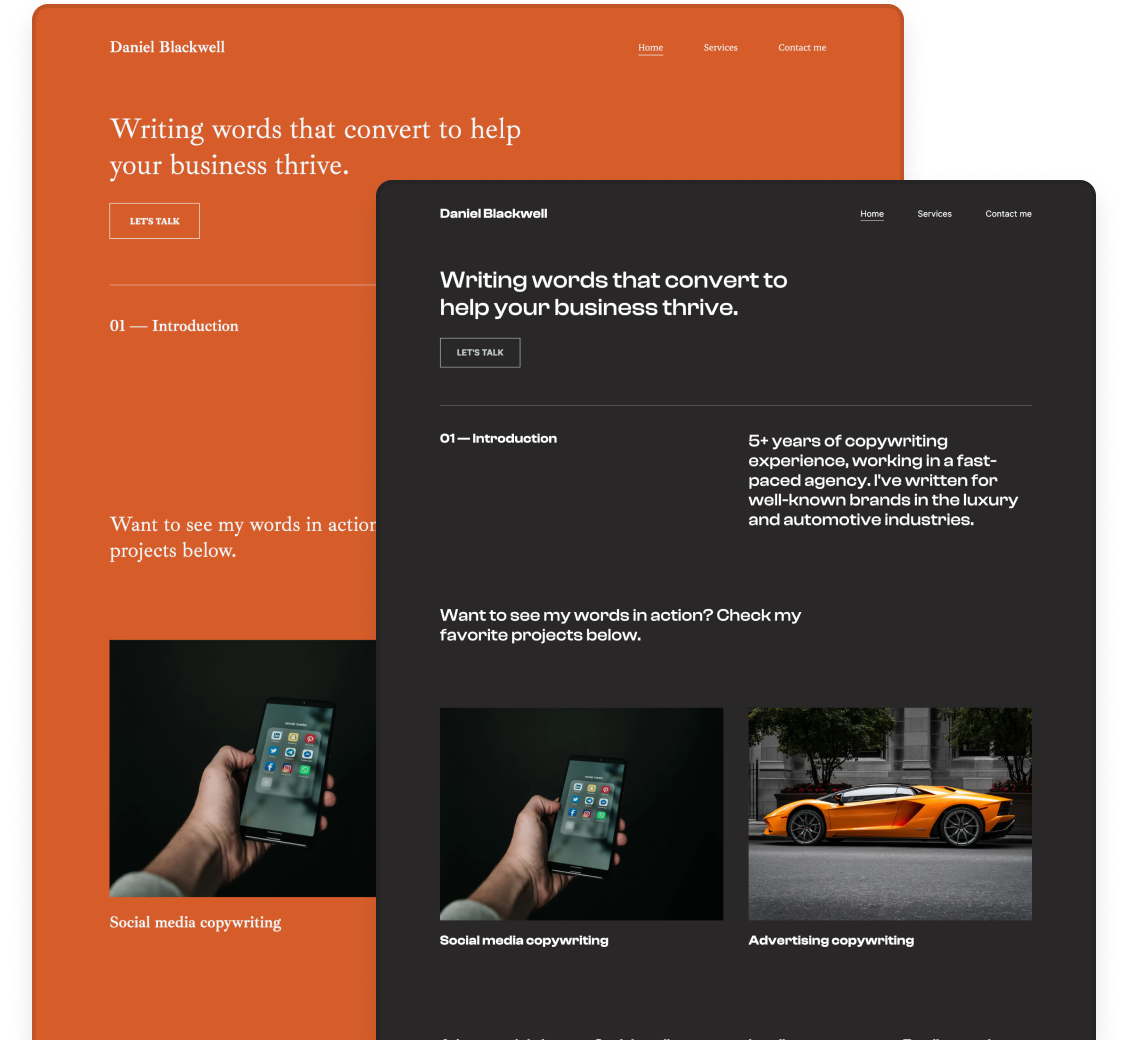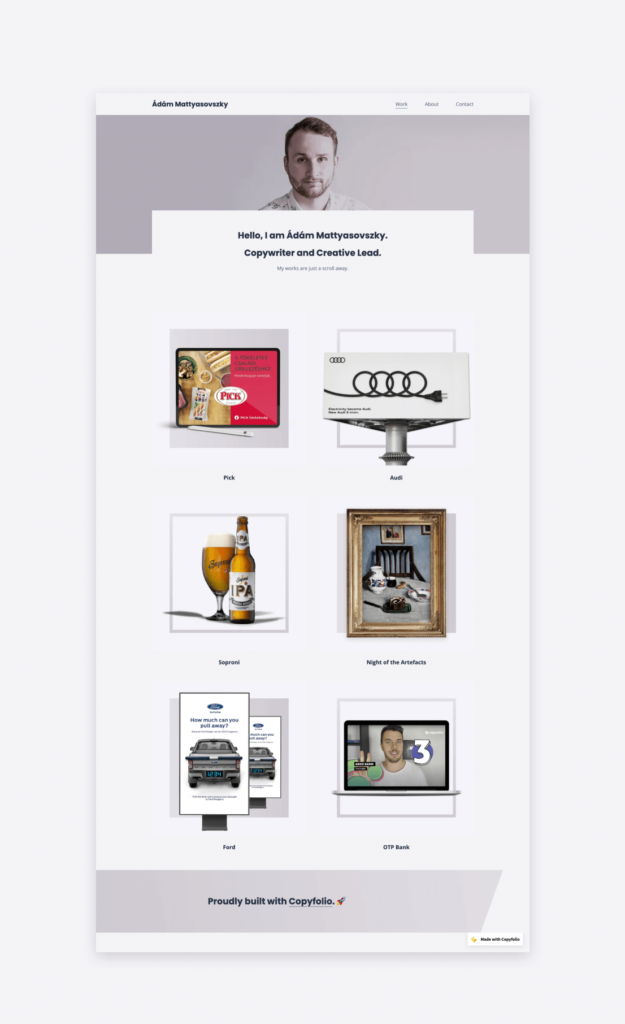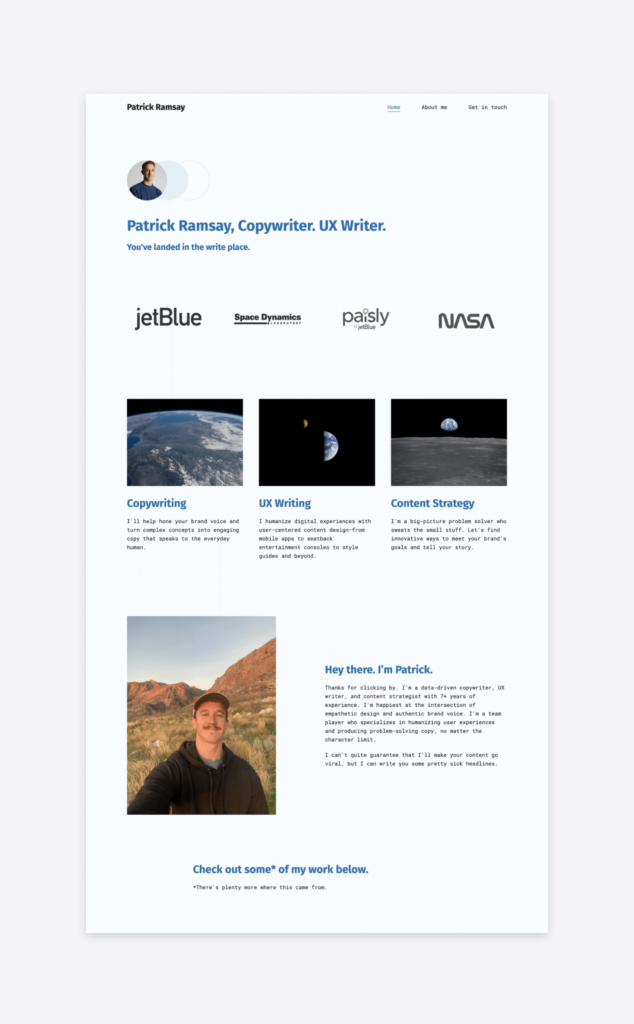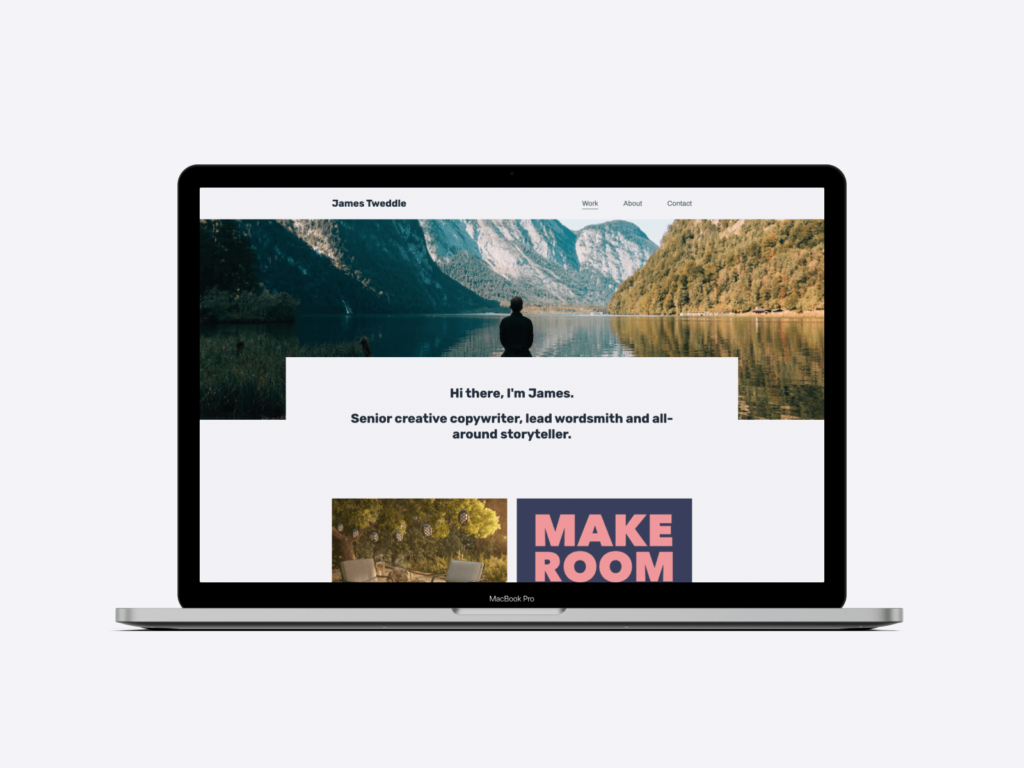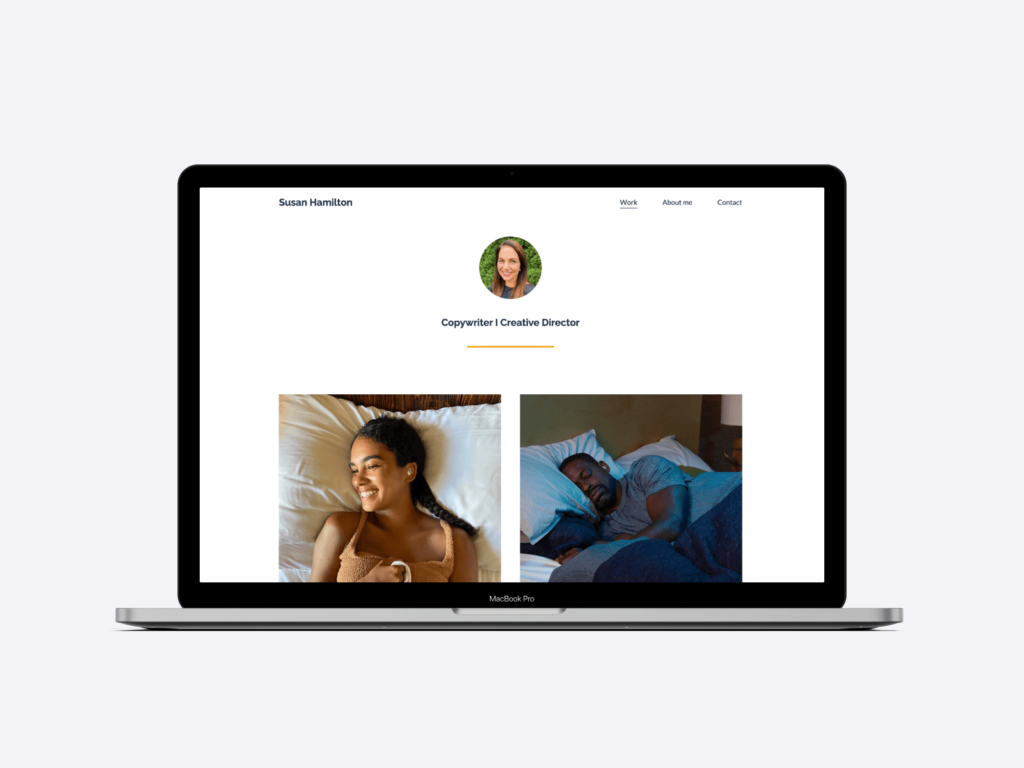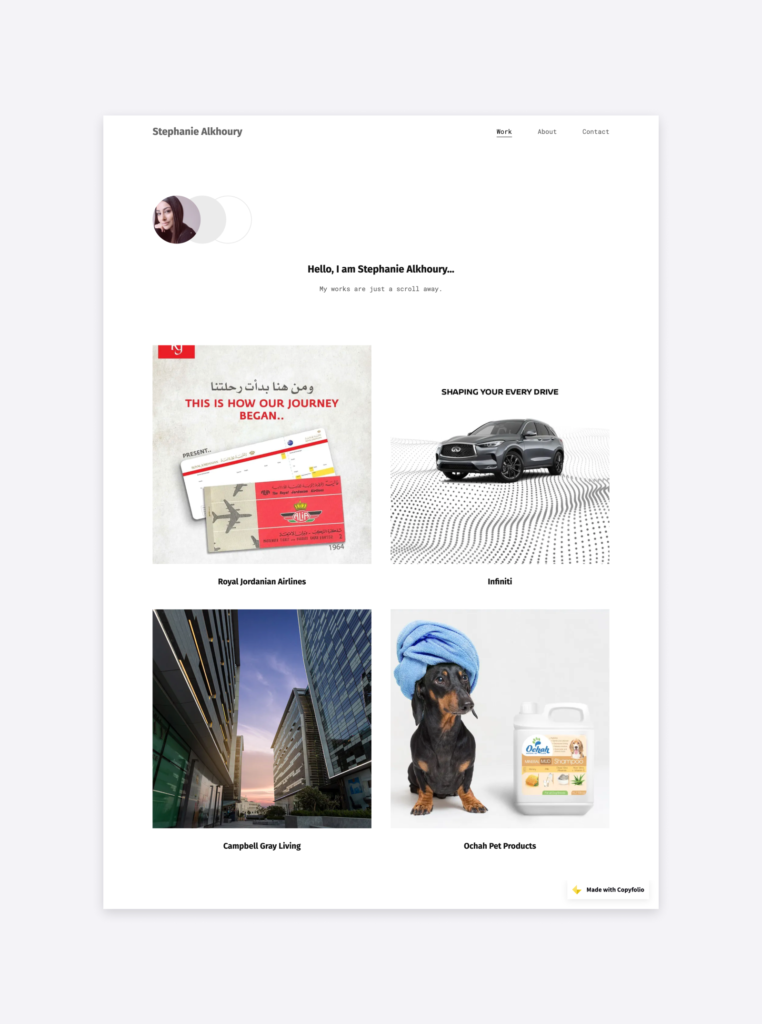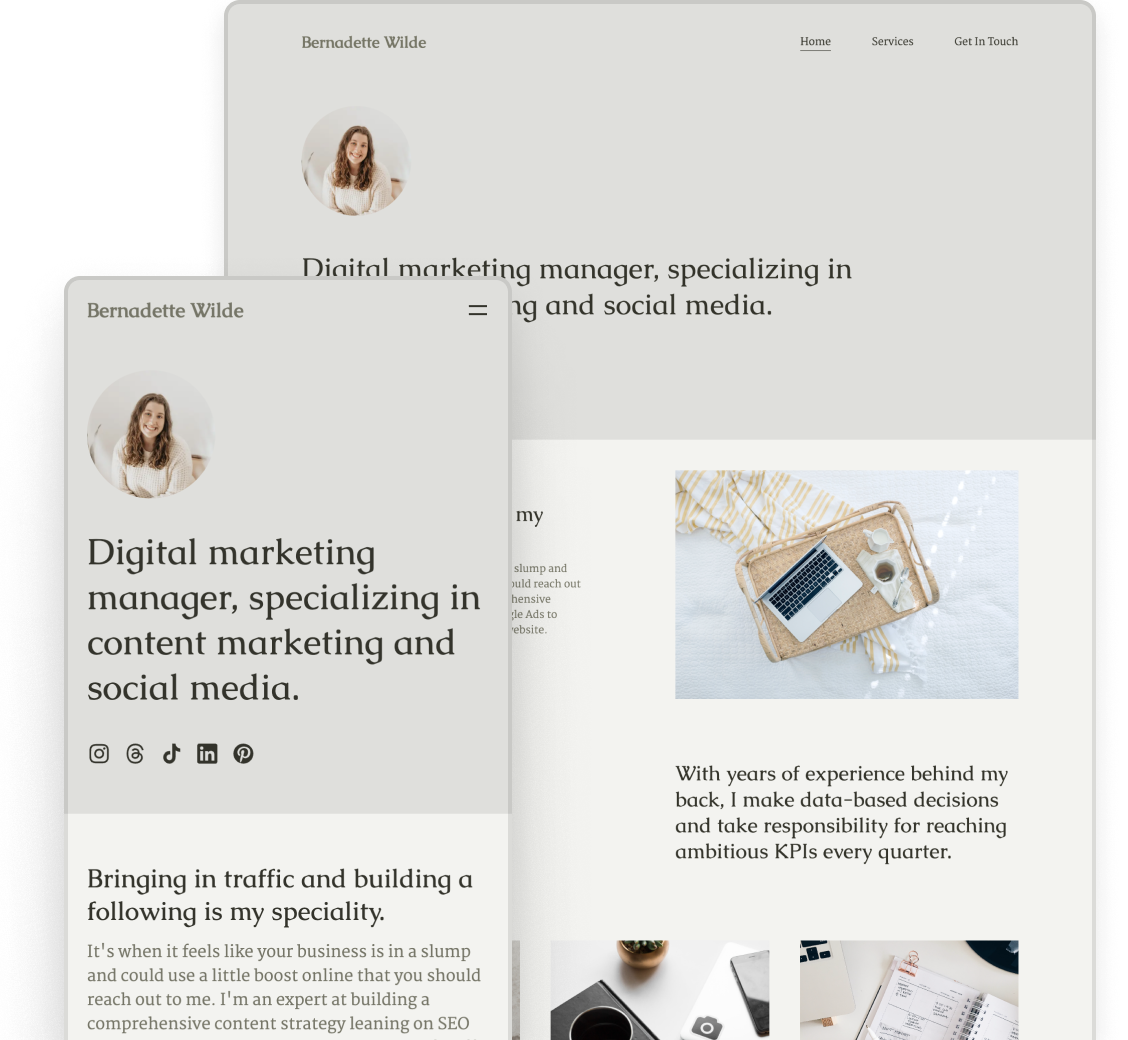7 Advertising Portfolio Examples & A Guide to Create Yours
When your job is to create eye-catching, memorable materials that make people want to take action, your professional online representation can be no less outstanding. Creating an advertising portfolio website that hits the bar can sound overwhelming, but it doesn’t have to be.
In this post, to help you with that, we’ll show you 7 stunning advertising portfolios to give you some inspiration. We’ll also talk about how to create a portfolio as a student with no experience, before diving into tips specific to the career path you take within the realm of advertising. And in the end, we’ll show you how to create an advertising portfolio website with Copyfolio in 4 easy steps.
7 advertising portfolio examples for inspiration
Adam created his portfolio using Copyfolio, and the "Billboard" template.
Brenna's portfolio was also designed with Copyfolio's "Billboard" template
Erica Sykora

Erica used Copyfolio's "Typewriter" template to build her advertising portfolio
Patrick also used the "Typewriter" template for his portfolio. Scroll down on his site to see his full homepage!
James created his portfolio with the legacy version of Copyfolio's "Billboard" template.
Susan chose the "Letterpress" template of Copyfolio for her advertising portfolio.
Stephanie went with Copyfolio's "Typewriter" template for her own portfolio
Student advertising portfolios: how to create a portfolio with no experience
The very first step of creating an advertising portfolio is usually getting your work samples together. But what are you to do, if you haven’t got any? As a student with no real work experience, getting samples is probably the most overwhelming part of the whole portfolio-building process.
But don’t worry —recruiters and creative directors know what it’s like to be just starting out and won’t have unrealistic expectations.
As Katie Bero, then creative director at DDB told us in an interview, “when you’re starting out, the whole thing can be made up,” she said. “I don’t expect you to have real brand work. That’s perfectly fine.”
3 ways to get samples for your advertising portfolio with no experience
To help you out with some ideas, let’s see 3 different ways of getting some samples for your starter portfolio.
- Make up a complete project. As Katie said, the whole thing can be made up. Think of a product, describe its positioning and target audience, and create a new campaign for it. None of it has to be real, except for your concept and the materials you create.
- Recreate/improve an existing campaign. If making up everything from scratch feels a little too much, you can take something that already exists and reimagine it —then explain the why behind your choices.
- Offer your help to friends, small businesses, or NGOs. With this method, you get to practice, create samples for your portfolio (of real-life work), and help out someone with their advertising. It’s a win on every front!
Tips for your advertising portfolio —Based on your career path
But what about portfolios when you already have an established career in advertising? Don’t worry, we’ve got you covered.
As career paths in advertising can vary a lot, we’ll overview a few different, popular positions to give you tailored tips for portfolio building.
Creative director
Creative director is a higher position within an advertising agency. You can become a CD after starting either as a copywriter or an art director —and your creative director portfolio should reflect that as well.
With many years of experience behind your back, you need to impress your potential clients and employers. Add a logo wall to your homepage to show the well-known brands and agencies you’ve worked with, and feature your most impressive projects only.
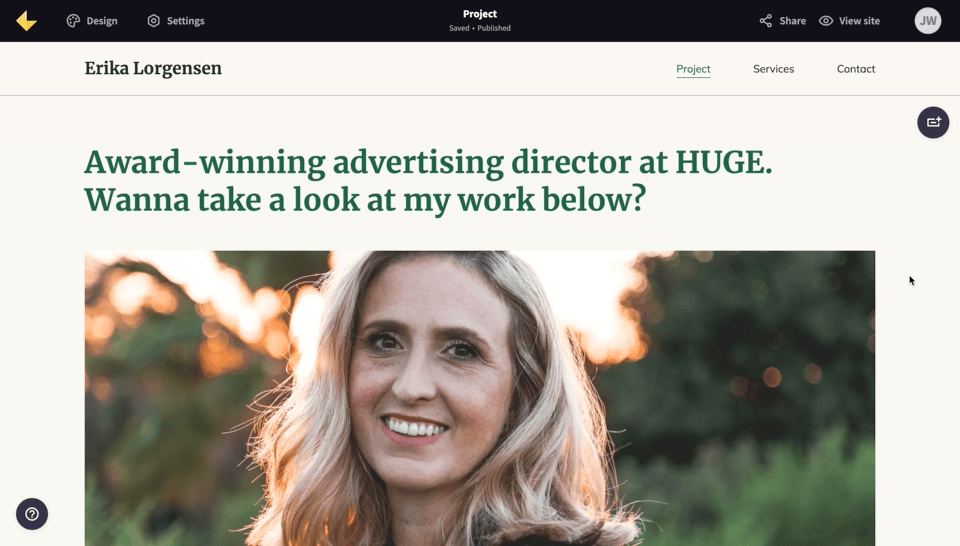
Add your CV, or at least a full list of those clients and agencies to your about page, as that’ll speak for itself. Even if you only feature a couple of your best projects.
Copywriter
As a copywriter, the focus of your advertising portfolio should be on the writing samples.
Sure, having worked for reputable brands is one thing, but the types of projects you worked on, and how you implemented their tone of voice, are still important. People like to see that in action.
So make sure you get straight into the projects after your initial tagline or short introduction. You can put all the details on the separate case study page you create for each. Make sure to mention the original brief you got, how you worked with your team, and what your creative process was coming up with the final idea.
Copyeditor
Copyediting is a little different —here you’ll have to show the difference you made. Case study pages are the way to go in this case too.
Add images next to each other to illustrate (some of) the edits, and explain underneath what you did exactly. Don’t worry about including the whole material, showing bits of it to highlight a few edits are more than enough.
Elaborating on the project type and possibly the performance of the finished product are great additions. You could also include recommendations from your colleagues or supervisors, describing how it was working with you.
Art director
On one hand, the output of art directors’ work is drastically different from copywriters and -editors, as they work on the graphics, not words. But on the other hand, the end result is the same advertising material —they just provided a different part of it.
That means the portfolio of an art director can be really similar to that of a copywriter: an introductory tagline, leading straight to the top projects. The projects should be displayed with prominent thumbnail images that lead to their respective pages.
On those pages, similarly to copywriters, you should talk a little bit about the brief, your creative process, and how you worked with others to produce the piece.
Brand strategist
Strategy is always harder to grasp than advertising campaigns, so a brand strategist’s advertising portfolio will be a little different from the ones above. In this case, you’ll have to do much more explanation —and your graphics will most likely be of analytics or campaign materials your teammates produced.
Instead of driving straight into the projects, have a section or two outlining your experience and expertise, and highlighting the things you achieved. You can already mention numbers here: the increase in brand awareness, sales, online visitors, and so on.
If you worked with reputable brands, definitely add their logos to your homepage at the start.
For your projects, write case studies where you explain where the brand started from when you joined, what kind of strategy you outlined for them, and how the company performed once they were implemented.
Do you pull more towards marketing? Check out our guide about marketing portfolios too!
Account manager
As an account manager, you’re the one that holds it all together. Keeping in touch with both the internal team and the clients, knowing who needs and does what, enforcing deadlines, writing briefs… It can be chaos. And it’s this chaos you’ll have to somehow turn into a portfolio. Let’s see how.
The key to a successful advertising portfolio as an account manager is focusing on the process and problem-solving. For each project, write about the team you worked with within the company and your contacts on the client’s side. Write about how you communicated with them, and what issues arose throughout. And of course, how you handled those.
You can also mention what the original client request was, how you briefed the team, and how the final product turned out.
Media planner, media buyer
These positions might not be as well-known outside of the advertising industry as copywriters or art directors, but they’re no less important. Because what’s the point of a well-planned advertising campaign, if it then doesn’t show up at the right places?
Whether you’re a media planner or buyer, in your portfolio you should focus on the strategies you used for each campaign and the communications that happened between you and your teammates or media owner counterparts.
As that is harder to visualize, feel free to either use visuals from the ad campaign itself (crediting the team that created it), or high-quality stock photos that illustrate your work to break up the text a little bit.
How to create an advertising portfolio in 4 easy steps
With all that said, there are some steps that are universal when it comes to creating a successful advertising portfolio. So let us walk you through the process step-by-step, illustrating it using Copyfolio.
Step 1: Create an account
Creating an account on a portfolio website builder is the very first step. On Copyfolio, it takes about 2 minutes, and at the end of it, you’ll have a basic site to start with.
Your starter site will have 3 pages, usually home, about, and contact —and they’ll all have pre-filled sections to give you some ideas.
Step 2: Setup your homepage
Although your homepage will have some sections ready for you, you might have to customize them a little. Rewrite your tagline if you want it to be more unique, and upload your picture to the top section.
Then add things like the mini about me section, logo walls, or testimonials that you’d want to see on your homepage. Don’t forget to include a CTA at the bottom, to optimize your portfolio for conversion as best as you can.
Step 3: Add your advertising projects
The most important elements of your portfolio (after the first impression your homepage makes) are your projects, so take some time to set them up properly.
In Copyfolio, all you have to do is scroll down on your homepage and click the “Add project” button to create a new one, along with a thumbnail for it.
The project can be:
- A case study, which appears as a new page on the website,
- A PDF file that opens in a new tab if you click on the thumbnail,
- Or an external link, also opening in a new tab once clicked.
Include 4-6 projects, as that can show enough of your experience, while not overwhelming the viewer with too much material.
Not sure what to write on a case study page? Don’t worry, Copyfolio has prompts and questions to guide you through the process. Just answer them all, and you’ll end up with an ideal case study. Not too long, but detailed enough.
Step 4: Fill out your about & contact pages
To put the cherry on top and finalize your site, you should go through your about and contact pages and fill them out as well.
The contact page will be the easiest: you can even just have your email address on there with a call to action, and call it a day. Or some people prefer contact forms —adding one only takes a second in Copyfolio.
As for your about page, think of who’s going to read it when you set it up. Include things that’ll show you’ll be a great team fit and that you’re an interesting individual… But don’t go too far and bore them with all the details of your personal life.
Something a lot of people forget about is adding a CTA to their about page too, even though it’s also an important conversion point. So tell them explicitly to download your CV, get in touch with you, or do whatever you’d like them to do on your site!
Create your advertising portfolio easily with Copyfolio!
Ready to get started with building your professional advertising portfolio website? All you have to do is head to Copyfolio, and follow the four steps we outlined above. If you have everything for your projects prepared, creating and setting up your portfolio site will take a matter of minutes!
Take it for a spin and enjoy the speedy editor, on-click mockups, quick global design changes, and more. Get started for free today!
